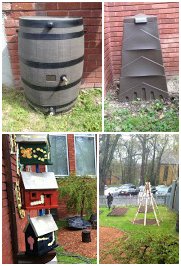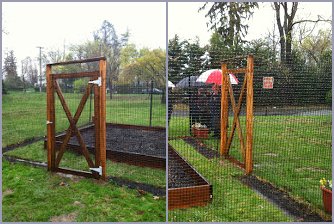A 2's and 3's Garden Grows in White Plains at Kol Ami
Site Visit Journal | 2s and 3s Garden Grows
Shariee Calderone
What do you do when the plot of land you carved out 5 years ago to incorporate a “4s Garden” is doing absolutely wonderful, BUT, it isn’t sunny enough to support a pumpkin patch… and you really really want one?
Well, if you are Congregation Kol Ami in White Plains, you commandeer another part of the property, this one plopped right on the front lawn, and you build yourself a Pumpkin Patch, which is now dedicated to the two- and three-year olds at the school.
What a pleasure it was to go back to Kol Ami and see the progress that’s been made in the 4s Garden that I visited just one year ago (on a dreary rainy day)! Well, this visit was also a dreary rainy day, but for the 15 or so educators who attended this last-of-the-season In-site-ful Journey Visit to a school of innovation, I hardly think they noticed at all. “Gardening has this really beautiful effect on us as humans”, said Dale Oberlander from Community Synagogue of Rye.
“It’s like a Zen experience; something really beautiful.”

Over the past year the 4s garden has added…
- A rain barrel
- A compost bin (last year’s post shows a loose pile in the corner)
- More art from the children
- And a tee pee inspired by the Nevatim Sprouts Conference at Pearlstone Retreat Center in 2012.
And of course there’s the new Pumpkin Patch which boasts a beautiful rustic entry way, high mesh fencing (I’m guessing to keep the deer out), and a narrow perimeter garden along the fence that has been planted with pea seeds (or is it pole beans?).

You can tell there is a great deal of pride that has gone into the development of this plot of land. Not only did they expand the garden but they’ve expanded the opportunity for more children to be enriched by the nature curriculum that has developed over the years. While the 4s Garden is tended to by the four-year olds, this new Pumpkin Patch will be primarily tended to by the two- and three-year olds.
As Susan Arovas, the school’s Nature Specialist, describes the evolution of the space you come to appreciate that not everything can happen at once, nor should it. After attending the Re-imagining School Grounds event in NYC a few years ago with Landscape Architect Ora Berman, which focused on local and international perspectives of school greening initiatives, I learned how important it is for educational leaders to think of their spaces as ever-changing environments, that not only should change periodically, but NEED to change. It’s a type of stewardship approach they explained. The suggestion is that those who help create it – invest the most in its care. By adding new elements to your design, expanding your space, or even re-purposing the space intentionally – like the school that intentionally plants trees they know they will cut down so students can create park benches for the community – you create a cycle of effort and reward by all who contribute year after year. The idea that we take care of the earth and the environment has significant connections to Jewish values as well.

During our visit we learned about the very beginning stages of the garden: how it was designed and the role the parents played in making it happen – Susan being one of them. In fact, it’s worth pointing out here that Nan Blank, the Early Childhood Director, has a very specific approach to getting things done at her school.
“When parents come to me with an idea, I try to entertain them and I try to make it happen in the year they are here.”
Nan’s referring to the speed at which she likes to see things happen. She’s definitely not an all-talk-and-no-action type of leader. For her, it has to be done swiftly and the parents are invested in the idea, the more she is there to support and advocate for it. With families moving through preschools as fast as Jr. High school students run through hallways between bells, there’s very little time to waste. If parents are going to see the rewards of their efforts, it has to be done now; and Nan embodies this notion without fail.

One of the things Susan does best at Kol Ami is to incorporate Jewish and universal values into her lessons. Respecting the environment, appreciating the beauty of the world, the value of hard work, curiosity, patience and collaboration are all discussed and talked about openly and specifically with the children. The unpredictability of a natural environment gives children plenty of opportunities to make predictions, test hypotheses, and extend their thinking beyond the here and now. Susan explains,
“It’s about problem solving too. We work together to decide what to do with the plants. When it’s cold out we discuss the risk of putting baby plants outdoors. I tell them ‘there’s still a risk that the ground might become hard again’, and then I let them decide what to do.”
She emphasizes the importance of letting the children have a sense of ownership over the garden which come with limitations and disappointments, but also with rewards. I’m particularly thinking about all the food the children get to harvest and taste each year such as different varieties of lettuces, radishes, carrots, broccoli (yes they love broccoli Susan says), squash, peas, and the list goes on. What lucky kids these are.
Susan works with the children all year long, although time spent in the garden in the winter isn’t as much as the time she spends with them in the Spring and in Fall. And with 5 years under her belt, and a lot of trial and error and learning what works best with the children – and not all things do (click here for a great blog on the messiness of gardening with children) – Susan has created a simple but well thought out seasonal curriculum that works. Holidays, school events, weather changes, and the need to plant and harvest at given times are all built in. She pays particular attention to process not product and says it’s really important for the children to use the
“best garden tools around… their hands.”
Because we were a large group we broke up into two groups for a portion of our visit. While one group went outside with Susan and watched as some of the children braved the rain and planted lettuce plants, the other group toured the school. I was so impressed during the school tour with the way Jewish content, culture and values were incorporated into the school setting that I am going to have a short post follow this one with lots of pictures and examples.
So instead, I will leave you with this, a passage written by Susan to the parents for the newsletter; one of many that is shared throughout the year on the happenings in the garden…
On Thursday, we met in the garden for the last time until spring. It was cold, and as one child observed, “everything looked bare.” The trees have lost their leaves; the vegetables growing in the garden beds are gone; and the lilies that line the perimeter of the garden are brown and flowerless. With so little to distract our eyes, we were able to observe things we cannot see other times of the year. First, we noticed that there are trees that have leaves, which fall in autumn (deciduous), and trees with needles that stay green all year round (coniferous). We learned that deciduous trees need to lose their leaves to protect their rigid branches during snowy winter weather. Coniferous trees, on the other hand, have flexible branches that can withstand snow. There’s nothing more beautiful in winter than snow-covered evergreens.
…to read the continuation of Susan’s message to the parents and her documentation of turning the student’s classroom into an olive oil factory for Chanukah, click here
And some quotes from our Journey participants…
- “I’m excited to bring this back to my school. It’s something that is going to enhance my pre-K curriculum for next year. I’m really looking forward to it… thank you.”
- “This type of curriculum hits upon a variety of learning styles.”
- “It [the garden] reminds me of design thinking and that it’s ok to fail forward. You’ve learned from it and it’s constantly evolving.”
- “I love the layout of the beds.”
- “You can see it took a village to make it work.”
- “It seems like it was done right… planned very well.”